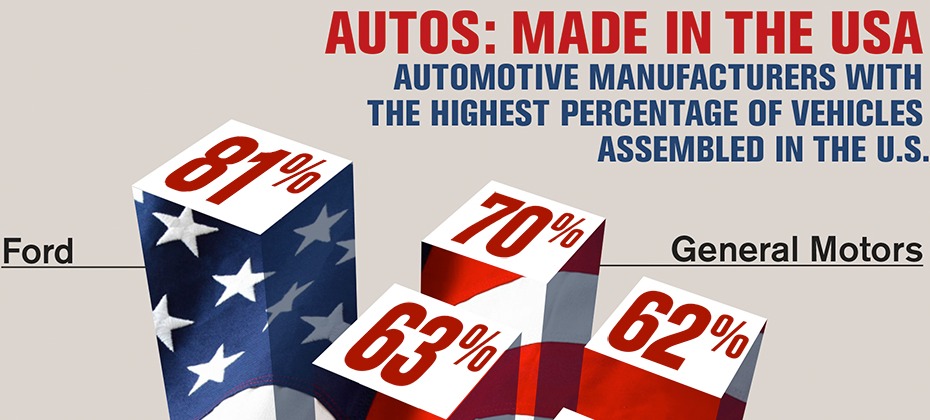
Who doesn’t love a new car? That new car smell, the excitement of seeing less than 8 miles on the odometer, or the invigorating rush you feel when driving your new baby off the lot. There is nothing like it! Well, according to a recent study we did here at Experian, it’s not just speculation, but completely true – folks like new cars! In fact, according to the latest Automotive Market Share Trends and Registrations analysis the number of new vehicle registrations in Q1 2016 reached a record high, climbing 7.5 percent from Q1 2015 and up 86.9 percent since the lowest point following the Great Recession in 2009. The analysis also showed that the top vehicle segments for these new registrations were the entry level CUV (15.09 percent), Full-sized pickup (11.35 percent), small economy car (9.86 percent, and the mid-range car standard (9.48 percent). The top vehicle models that consumers chose and registered in Q1 2016 were the Ford F150, Honda Civic, Chevrolet Silverado 1500, Honda Accord and the Honda CR-V. Other areas covered in the analysis include: Vehicles in operation statistics Top registered manufacturers, makes and models Average vehicle age information Luxury segment market share Insights into the medium/heavy vehicle market Automotive aftermarket trends If you’d like to see the full report with additional information regarding this analysis, please view the webinar by clicking here.

The Fourth of July is a special day to celebrate our independence and to show off American pride with parades, fireworks and barbecues spent with friends and family. In the spirit of this season, Experian Automotive recently conducted some research that looked at the vehicles on U.S. roads to see how many were manufactured in America or that were “Born in the USA.” According to our latest research, there are roughly 260 million light-duty vehicles on the road, with nearly 60 percent of them having been assembled domestically. The rest were built in Canada, Japan, Mexico, Germany, South Korea and others countries. From a manufacturer standpoint, it is not surprising that Ford, General Motors and Fiat Chrysler Automobiles had the highest percentage of U.S.-made vehicles currently on the road at 81.2 percent, 70.1 percent and 63.1 percent, respectively. However, Honda (61.9 percent) and Nissan (54.7 percent) also made the top five. In fact, many of the top import manufacturers hover around the 50 percent mark, including Mitsubishi (49.9 percent), Toyota (48.2 percent) and Subaru (47 percent) assembling vehicles in the USA. When looking at vehicle brands, the findings show that, overall, Jeep is the most American with 96.7 percent of its vehicles assembled in the USA. Rounding out the top five were Oldsmobile, Saturn, Ford and Cadillac, with 93.3 percent, 92.4 percent, 83.1 percent and 80.6 percent, respectively. In addition, nearly 93 percent of Ford F150s, the most popular model on the road, were built domestically. The remainder of the top five vehicle models assembled domestically are Honda Accord (88.3 percent), Toyota Camry (86.9 percent), Nissan Altima (100 percent) and Ford Explorer (100 percent). The analysis also looked at domestically assembled models that were most often financed with a loan rather than with a lease or paid for with cash. At the top of the list, the Ford F-150 was the most popular vehicle that was financed with a loan with 69.9 percent, followed by Nissan Altima, Toyota Camry, Honda Accord and Ford Explorer. For more information about this analysis or Experian Automotive insights, visit https://www.experian.com/automotive.

Independent research firm cites Experian as having the most capabilities and one of the highest estimated revenues in total fraud management Experian announced today that we were included in Forrester’s 2016 “Vendor Landscape: Mobile Fraud Management Solutions[1]” report. The full press release is available on our Insights blog. Experian was listed as having nine out of a possible 10 capabilities needed to combat mobile fraud. In addition, Experian was cited as having one of the highest total fraud management revenues in 2015, between $200 million and $250 million. Only one other vendor in the report was cited with revenue over $200 million. Through what we consider to be this significant market presence, Experian provides fraud management solutions to some of the world’s largest brands in financial services, insurance, and retail. “We believe the findings in this report further validate the power of Experian’s fraud management solutions,” said Steve Platt, global executive vice president, Fraud and Identity, Experian. “There is incredible innovation taking place in mobile today and our clients need to be able to keep up with the pace of change, while also providing reliable protection. We feel this report is a noteworthy validation of our commitment to building a safer environment for consumers across the globe while ensuring a positive customer experience.” A complimentary copy of the June 2016 Forrester report by analyst Andras Cser is now available here. [1] Vendor Landscape: Mobile Fraud Management Solutions, Forrester Research, Inc., June 2016

Industry’s first smart plug-and-play fraud platform allows companies to connect their own solutions, Experian products and third-party vendors in one place to better protect their customers from fraud threats Experian unveiled the fraud and identity industry’s first open platform designed to catch fraud faster, improve compliance and enhance the customer experience. Fraud attacks change at such a fast pace that right now it’s a challenge for clients to manage all the tools they need to keep up. Experian’s CrossCore™ lets them plug all their fraud and ID services into a single platform, easily adding new ones, from Experian and others, when needed. This means they can make decisions – with more confidence – more quickly, making life easier for their customers. “Our clients have expressed frustration over the lack of a truly holistic industry solution that delivers the level of confidence and control they need without requiring a massive multiyear project to replace everything they have,” said Steve Platt, global executive vice president, Fraud and Identity, Experian. “New fraud threats, updates to regulatory requirements and customer expectations for a hassle-free experience are making it challenging for fraud and compliance teams to keep up. CrossCore will give them the flexibility they need to balance customer protection with customer experience.” Please read the full release here and learn more about CrossCore capabilities.

Small businesses serve as the engine of job creation for local communities, as well as the central hub for most innovation. So, it stands to reason that the financial health and growth of small businesses are of the upmost importance to all parties involved. Fortunately for the economy, the financial health of small businesses has remained relatively unchanged from a year ago – which is a good sign. In fact, according to the first quarter 2016 Experian/Moody’s Analytics Main Street Report, delinquency and bankruptcy rates have held steady at rather low levels. And we’re seeing fewer small businesses fall within the 61 to 90 and 91+ days past due categories. Additionally, while small businesses have continued to pay their bills in a timely manner, we’re also seeing them expand their credit lines and keeping utilization rates down. This is a pleasant sign, as it means small businesses have the ability to access financial resources if necessary. However, while the credit conditions for small businesses have remained stable, there are potential headwinds that could impact the sector. For instance, findings from the report show as oil prices have gone down, so too has the price on agricultural commodities. If both continue to remain low, there could be potential increases in delinquency rates for the oil and agricultural industries, which could spread into other small business areas. While the financial health of small businesses remains positive, it will be important for credit grantors and small business owners, to keep an eye on the potential challenges that they could encounter in the near term. Gaining insight into the fluctuations of the market can not only help them adapt to these challenges, but also better position small businesses to grow and succeed. In-depth insight and commentary from the Experian/Moody’s Analytics Main Street Report will be presented in a Webinar at 10 a.m. Pacific time/1 p.m. Eastern time on June 28. If you would like to register for the event, visit http://bit.ly/1s6vlmG.

In this eCampusNews article by Eric Haller, Executive Vice President of Experian’s DataLabs, he discusses how the rising cost of college tuition against the backdrop of a challenging job market brings new meaning to the question “What do you want to be when you grow up?” Once a question of endearment for the young and imaginative, today’s students focus on what will pay the bills; what career will provide the means to pay back loans; what is the next profession to boom. The medical and law professions used to top the list. Now, a new player is ready to take the top spot: data scientists. http://www.ecampusnews.com/curriculum/data-science-hot/


